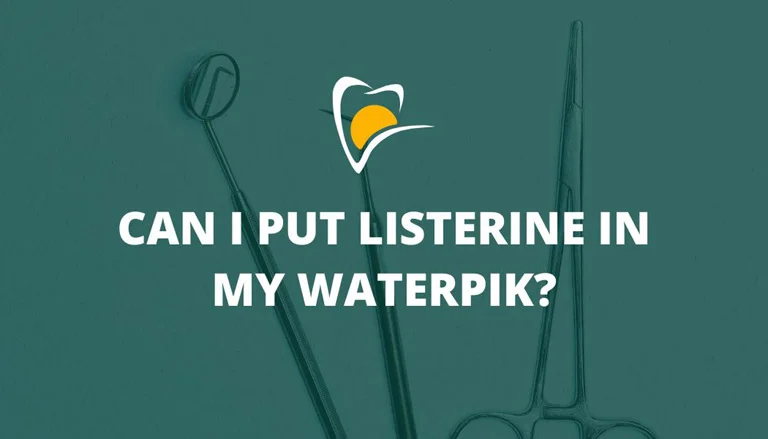Can i put listerine in my waterpik? Listerine and chlorhexidine have been deemed safe for use with Waterpiks. Adding mouthwash in a Waterpik water flosser can be an excellent method to clean your teeth while also keeping your breath fresh.
Water flossers run just on water, but what about mixing in mouthwash or other dental rinses?
Each water flossing device will come with manufacturer-approved usage instructions, and it is normally suggested to floss with warm water. Using the unsuitable mouthwash in your Waterpik, on the other hand, has the potential to harm the Waterpik.
However, a small amount of mouthwash not only adds taste to the water but also increases the effectiveness of your dental hygiene.
Why Should You Use Listerine in Waterpik?
- Waterpiks effectively remove debris and plaque, while Listerine adds an extra layer of targeted cleaning, ensuring a thorough oral hygiene routine.
- Using it in your Waterpik can help target and eliminate harmful bacteria in hard-to-reach areas of your mouth.
- Water flossers distribute Listerine evenly throughout your oral cavity, reaching areas that traditional rinsing might not effectively target.
- Incorporating Listerine into your Waterpik routine is convenient and comfortable, making it easier to maintain consistent oral care habits.
Consult your dentist or dental professional before starting Listerine usage in your Waterpik, especially if you have specific oral health concerns. Remember that Listerine is a supplement to your oral hygiene routine.
Mouthwash Compatibility with Water Flossers: Can I Put Listerine In My Waterpik?
Listerine’s ability to combat bad breath can leave you with a refreshed and confident smile. The combination of Listerine and water flossing can give you a healthy gums and reduce the risk of gum disease.
Follow Waterpik’s recommendations for proper dilution ratios. Generally, a recommended ratio is 1:1 of Listerine to water. Before integrating Listerine into your Waterpik routine, seek guidance from your dentist. Remember that Listerine is a supplement to regular brushing, flossing, and professional dental visits.
Can I Put Listerine In My Waterpik?
While the majority of mouthwashes are not recommended due to their potential to damage the device, Listerine and chlorhexidine are two exceptions that Waterpik has identified as compatible options. Start with occasional use and observe how your gums and oral tissues respond.
Combining a compatible mouthwash with your Waterpik can provide an extra layer of cleaning. The pulsating water stream helps distribute the mouthwash throughout your oral cavity, reaching areas that traditional rinsing might miss.
Mouthwashes like chlorhexidine, known for their antibacterial properties, can help target gum health and combat gum disease by reducing the presence of harmful bacteria. Using a mouthwash with a water flosser can help eliminate bacteria responsible for bad breath, leaving you with a fresher and more confident smile.
The Dos and Don’ts When Using Listerine in a Waterpik
Dos
- It’s important to verify the compatibility of any mouthwash with the manufacturer before use.
- Dilute the mouthwash as directed by both the mouthwash manufacturer and Waterpik, especially if it’s a concentrated formula.
- Adhere to Waterpik’s guidelines for using mouthwash with their devices.
- Fill the reservoir halfway with warm water and a few drops of mouthwash. To avoid damaging the device, do not exceed the mouthwash-to-water ratio of 1:1.
- Use waterp[ik as mentioned in the Waterpik user instructions.
- After flossing, fill the reservoir halfway with regular warm water and run it into the sink with the tip pointed down.
- Consult your dentist or dental professional before incorporating mouthwash into your water flossing routine.
Don’ts
- Putting any of these mouthwashes to your water flosser’s reservoir may reduce performance and diminish the Waterpik’s lifespan.
- Essential oils (tea tree oil, for example)
- Iodine
- Saline solution in cordless water flossers
- Do not swallow the Listerine-water mixture during the flossing process.
- Using Listerine in your Waterpik should complement your regular oral care routine, not replace it entirely.
- Do not use undiluted Listerine or other concentrated mouthwashes in your Waterpik, as it can lead to discomfort and potential damage to the device.
Wrap up
Can i put listerine in my waterpik? According to Waterpik, Listerine and chlorhexidine are known to be safe options. With the right approach, using Listerine in your Waterpik can contribute to a cleaner, healthier, and more confident smile.
The benefit of enhanced cleaning, improved gum health, and fresher breath is a healthy gum. Remember, individual oral health needs vary, so consulting your dentist or dental professional is essential before introducing mouthwash into your water flossing routine.
FAQ
A small amount of mouthwash not only adds taste to the water but also improves the efficiency of your dental hygiene practice. According to Waterpik, a prominent brand of water flosser, chlorhexidine and Listerine have been clinically tested for safe usage in a water flosser.
Water Flossers provide a unique advantage by evenly distributing the mouthwash throughout your oral cavity, reaching areas that traditional rinsing might miss. Mouthwash, especially those with antibacterial properties, can contribute to enhanced oral hygiene by targeting harmful bacteria in the oral cavity.
Diluted household Chloride bleach (Sodium Hypochlorite) or other items added to the water in the Waterpik reservoir helps in the maintenance of oral biofilm, hence improving gum health and preventing cavities.
Any toothpaste, even those containing baking soda, can be used with Waterpik. The hose must be connected in order to Water Floss. Warm water should be added to the reservoir. While using a Water Flosser for the first time, it is best to start at the lowest pressure setting and gradually raise the pressure.
While the recent study found that mouth rinses (Listerine and Chlorhexidine) were ” as excellent as” dental floss in antigingival efficacy, they can be prescribed for patients with gingivitis as a supplement to their typical home care routine.

